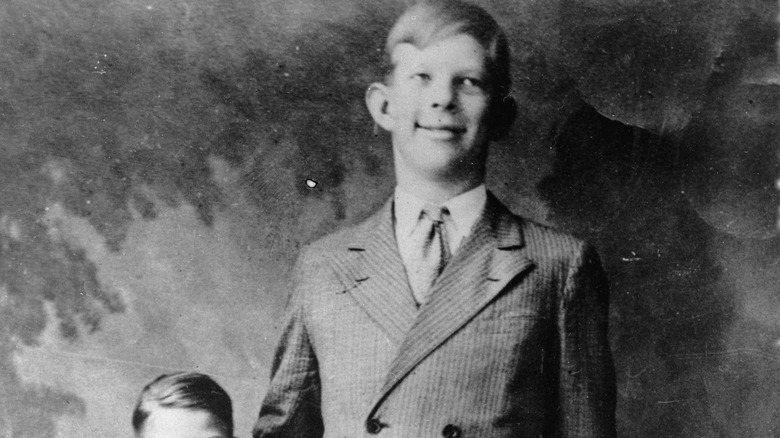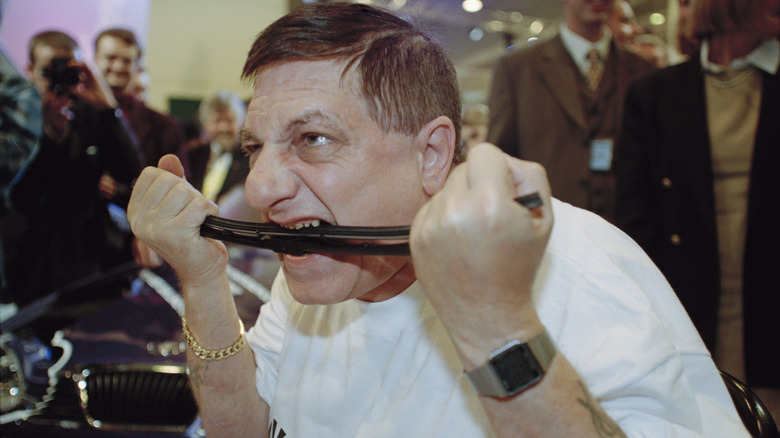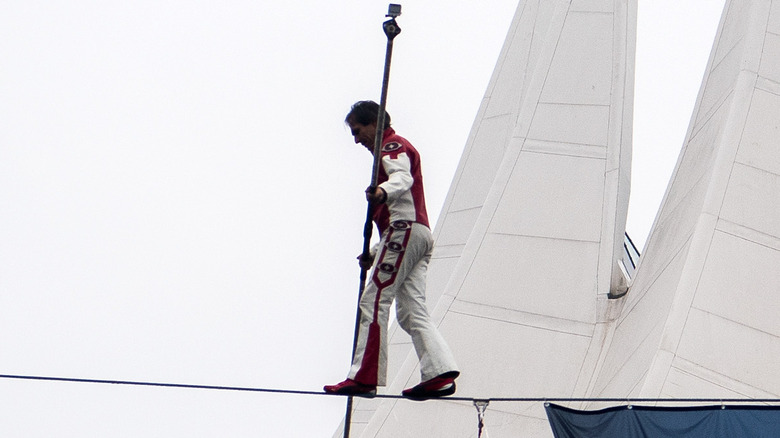Guinness World Records That Are Nearly Impossible To Beat
"Guinness World Records," often incorrectly referred to as "The Guinness Book of World Records," is one of the bestselling books in the history of the English language, and its annual edition has been warmly greeted by fans every year since the 1950s. The treasury of world records of every kind was reportedly created to help settle bar bets — the Guinness book would have the confirmed, vetted, listed, and inarguable records listed for everything from tallest building to tallest human to deadliest war to most hamburgers eaten in one sitting.
Generations have loved "Guinness World Records," and a rare few have decided to take their fandom to the next level and try to get themselves into a future iteration of the book by setting a new record or breaking an existing one. To be the very best at anything, in history, is a tough task, and some Guinness records are harder than others to break. Some are so tough that, for a variety of reasons, they may never fall. Here are some official "Guinness World Records" listings that it's probably not worth devoting your life to breaking.
The strength records of one man are too varied and weird to fall
Kevin Fast has gone about as far as he can go in his two major pursuits — his career and calling and his hobby as a strongman. Fast is technically "Rev. Fast," and he presides over St. Paul's Lutheran Church in Cobourg, Ontario, according to WTAE. He generally doesn't speak about his feats of strength during church services, nor does he speak about his faith while performing unequaled and record-breaking acts that push his body to its absolute limits.
In 2009, he completed the impossible-sounding task of dragging a 188-ton jet a distance of about 28 feet. Fast is also the record-holder for pulling the heaviest vehicle the farthest, tying himself to a 218,000-pound truck and moving it 100 feet. He even once pulled a record 15 cars (all Mazdas) all at once in 2014.
One other weird demonstration of strength — 11 people weighing more than 1,700 pounds stood on a platform on Fast's back in 2013. As of 2020, his name appears in "Guinness World Records" around a dozen times, easily making Fast not only one of the world's strongest (and most creatively and variedly mighty) people but also probably the world's toughest preacher.
You can't train to become the tallest person on Earth
The things found in "Guinness World Records" are an achievement. A bizarre achievement but a goal accomplished nonetheless. Record holders set out to get themselves listed in the Guinness book and they did, devoting an astounding amount of time and energy toward that successful end. But there are plenty of records in the Guinness reference book that didn't come from trying but rather a lack thereof. Numerous Guinness records are for fluke natural occurrences that didn't take any preparation whatsoever, such as biological oddities and superlatives.
Robert Wadlow is one of these unique record-holders, listed in the first "Guinness World Records" book way back in 1955 as the "Tallest man (ever)." In 1940, the American man's height was recorded at 2.72 meters, or 8 feet, 11.1 inches. Wadlow's height was the result of a medical condition called pituitary gigantism, which, in the early 20th century, wasn't as effectively treated as it was today. People diagnosed with pituitary gigantism now have access to medical solutions that can prevent tremendous, Wadlow-like height. That means that Wadlow will probably stay in the Guinness books for the foreseeable future.
Eating tons of metal doesn't sound very pleasant
"Guinness World Records" vaguely lists Michel Lotito as the individual with the all-time "strangest diet." More specifically, the France-born individual, born in 1950, entered the record books at the age of 9 because of his compulsion — and anomalous ability to process and digest — things that were not food. X-rays on his stomach obtained by gastroenterologists revealed that Lotito really could maintain a diet consisting primarily of metal. He ate around 2 pounds of it a day, supplementing all that aluminum and steel with some glass.
Beginning in 1966, Lotito made a show of his condition, slowly consuming entire vehicles and objects over time, including 18 bikes, 15 grocery carts, seven TV sets, a couple of beds, some skis, a computer, and even a small Cessna airplane. By 1997, Lotito had eaten a total of around 9 tons of metal. He died in 2007 of natural causes but not before he, ironically, consumed an entire coffin.
The desire or deep need to eat non-food is a condition called pica, which is treatable with modern medical methods and technology, says Healthline. People no longer suffer from the disease to the extent that Lotito did, meaning his years-long, record-setting acts of metal consumption will likely remain in "Guinness World Records" for years to come.
Breaking the record for most lawsuits could land you in court
Busting the Guinness World Record held by Jonathan Lee Riches would likely come at great personal financial expense. In 2009, according to ABC News, Riches learned that Guinness planned to list him as the most litigious man in the world — or the man who has filed the most lawsuits.
An incarcerated federal prisoner at the time (over charges of wire fraud), Riches (who also goes by the name Irving Picard) used the legal system to his advantage and made plans to sue Guinness because the organization stated that he sued a lot of individuals and companies. In his filing, Riches alleged that Guinness had its facts wrong, citing a letter of congratulations from the organization that stated he'd filed 5,500 lawsuits, while he contested that the number was closer to 4,000 (which is still a lot of lawsuits and still makes him worthy of Guinness).
Riches' previous filings (which aren't cheap to argue) include suits against New England Patriots coach Bill Belichick (for allegedly running an illegal surveillance operation) and Martha Stewart (over what he claims was a real estate deal gone wrong and that her birds assaulted him).
The fastest knockout in boxing history is probably unbreakable
Every sport has its own set of records, and in each annually published volume of "Guinness World Records," many of those are collected and shared with readers, particularly the oddest, most improbable, and most astounding ones. Take for example an enduring chestnut from the Guinness series – "Fastest knockout." According to the records-compiling publisher, in a November 1947 tournament held by the illustrious Golden Gloves amateur boxing circuit, Mike Collins squared off against Pat Brownson. Immediately after the starting bell rang, Collins delivered a massive punch to Brownson, sending him to the floor of the ring and ultimately out for the count. Collins won the fight in a knockout, with the match officially lasting just four seconds.
Collins' record is not likely to be broken. There's the matter of it already standing for more than 70 years in a sport that's only grown more competitive and sophisticated. It's also virtually impossible to make a boxing match go on for less than four seconds — delivering a single knockout blow that sends a guy to the mat couldn't feasibly happen in any smaller period of time.
Do you really want to cover your body in bees?
According to the "Guinness World Records" website, "bee bearding" dates back to 19th century carnivals. Sideshow entertainers would carefully place a queen bee on their bodies, prompting her hive to follow, forming a beard-like assemblage on the performer's face. Why have a bunch of bees on one's face when they can have them on their entire body, or a "mantle" of them? Those were apparently the thoughts of Ruan Liangming, who in 2016 set the record in Jiangxi Province for "heaviest mantle of bees." Filmed as part of a Guinness TV special, assistants dumped buckets containing slightly more than 140 pounds of bees onto Liangming, a veteran daredevil and entertainer.
Most rational people tend to avoid bees, afraid of or allergic to the sting of a single one. The average person isn't likely to welcome bees to rest on their body for an extended period of time, especially not in such a high volume that they're measured in pounds instead of by how many individual insects are present. Whoever truly holds the record for this daring act of animal companionship, and who committed themselves to the difficult task of taming and treating bees to the extent where they'd land on a human body at all, will probably hold their record for a long time.
Walking a tightrope is just too potentially deadly
The longer a "Guinness World Records" record goes without anybody breaking it, the more likely it is that such a feat will probably endure indefinitely. But if somebody does manage to top the original record, well, then it's probably going to be a long time before anybody beats it again — some records are just that difficult and monumental.
To name one instance of this concept, there's Philippe Petit, who in August 1974 walked a tightrope between the two, twin towers of the World Trade Center in New York City. That set the Guinness-recognized world record for "highest tightrope walk" (via Guinness World Records). It took more than 30 years — until 2015 — for somebody to traverse a higher tightrope. Freddy Nock did it, crossing a crevice over the Alps, walking to Piz Prievlus, one of the highest mountains in that range.
This is obviously a tough thing to do and to pull out all the stops to be just a little better than the previous record holder at that. But this one is so dangerous — a person could plunge to their deaths thousands of feet below at any moment during their attempt — that it certainly diminishes the playing field of potential record-seekers.
To assemble the world's oldest gang is asking a lot
There's really a Guinness World Record for virtually anything. Put a couple of adjectives together, and the long-running trivia book probably has a listing about somebody who fits those criteria doing something that nobody else ever did. One example of this phenomenon is the world record for "Oldest criminal gang (average age)."
According to the organization's website, in March 2009, Guinness recognized a United Kingdom criminal enterprise (that probably wasn't looking for attention or plaudits) operating out of London and Glasgow consisting entirely of retirees (or "pensioners" in British parlance) that supplemented their collective income by counterfeiting currency. With professional-grade printing operations in two cities, the group could make about £800 (or $1,600) in about 30 minutes, with police recovering a total of £5 million ($10 million) in fake bills. The oldest member of the gang was 83, while the average age was 57.
Any attempts to break this record would bring with it logistical issues and substantial risk. First, the organizer would have to be of advanced age, and then they'd have to recruit enough other people to get the average age above 57, and then they'd have to convince them to commit crimes. This all feels very unlikely.
This world record would have you looking sharp
Rolf Buchholz of Dortmund, Germany, has a distinctive look. He's a body modification aficionado, meaning he loves tattoos (he's been inked up dozens of times), implants (he has artificial horns in his head, reports News 18), and especially piercings. In August 2010, Guinness officially proclaimed Buchholz as the male with the "most piercings." At that time, Buchholz had 453 piercings, including 158 around his mouth, 94 in his lips, 25 in his eyebrows, and eight in his nose.
Topping Buchholz would be a difficult task. He's covered almost every surface on his body that can be pierced with a piercing of some kind, meaning any challengers to his Guinness record would have to find a way to double up in some areas. Also, one piercing is plenty painful, let alone more than 400, which will probably dissuade most people from ever attempting to topple Buchholz. (One other staggering statistic about this Guinness World Record holder — of his nearly 500 piercings, 278 are on Buchholz's genitals.
Some food-related records were banned by Guinness
Some "Guinness World Records" entries will probably be upheld by their holders forever not because what they did is impossible, but because what they did is so dangerous or untoward in retrospect that Guinness notes it no longer "monitors," tracks, or regularly lists.
For example, in the 1990s, the publisher opted to stop accepting submissions from wannabe record holders in categories related to what it calls "unfettered gluttony." This doesn't mean eating contests, which are held to a short, biological damage-diminishing time frame or limited to a specific number of food items eaten the fastest. By unfettered gluttony, Guinness means defunct record holders like Edward Abraham Miller. The Oakland, California, man was recognized by Guinness in its 1983 edition as the world's most prolific eater, who regularly consumed 25,000 calories a day and never lost an eating contest in the early decades of the 20th century. As the late Miller's record was never defeated before Guinness discontinued challenges to it, it's safe with him.
Guinness got rid of some animal-based records
The world has changed a lot since Guinness started publishing its annual line of record books in the 1950s. The company has evolved and states that it will no longer recognize, list, or accept record applications for achievements that could now be considered cruel or controversial, such as sports that involve the maiming or killing of animals, including elephant polo, camel wrestling, and bullfighting.
Also included in that category, and thus no longer included in the Guinness World Record books, is the traditional English countryside sport of fox hunting, in which a group of men on horseback set loose a fox and then chase after it with dogs — and then, at the end, kill it. As Guinness has declined to publish fox hunting records anymore, one achieved in 1936 will technically not be broken. During a hunt in the Cumberland region, a hunting party tracked down and killed a fox weighing 23.75 pounds, the largest ever destroyed in a fox hunt.
What's the record for most Guinness World Records?
Obtaining a Guinness World Record (or usurping it from someone else) is a very hard thing to do — a person literally has to be the very best in the world at one particular thing. The odds against a person ever appearing in the Guinness books are staggering, and they're positively infinitesimal against holding multiple records. That's because achieving only one record requires time, patience, and focus — time, patience, and focus left over to go after more records is downright miraculous. But this describes the life trajectory of Ashrita Furman. The Brooklyn-born man is in the Guinness World Records Hall of Fame for good reason — he's the publisher's "most prolific record-breaker."
In other words, the man who made it his stated life goal more than three decades ago to be in the "Guinness World Records" book as much as possible did just that. Furman personally set more than 600 records, and he currently lays claim to more than 200. To overtake Furman would require a lot of record-breaking, and in disparate areas, too, such as spending more time than he did balancing a chainsaw on his chin, most torches lit and put out in under a minute, fastest mile covered on a pogo stick, and the most distance covered on a bicycle while balancing a milk bottle atop his nose.












